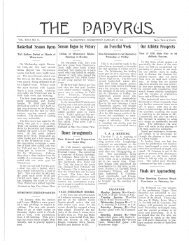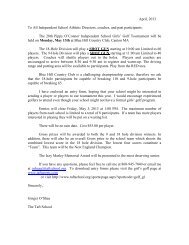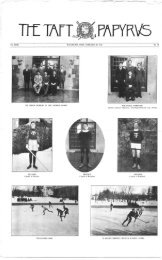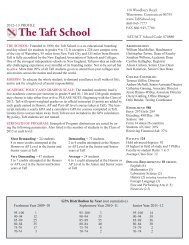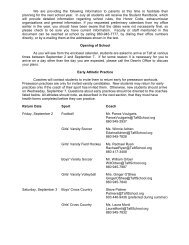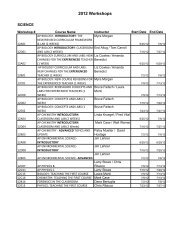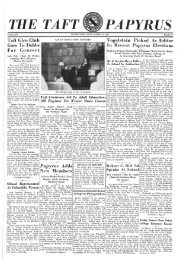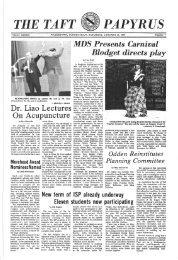Download - The Taft School
Download - The Taft School
Download - The Taft School
Create successful ePaper yourself
Turn your PDF publications into a flip-book with our unique Google optimized e-Paper software.
n David Ward ’46 modeling the Jet XX Vest in<br />
1962. H. Gates, Pictorial Division AMSC, Redstone<br />
Arsenal, Ala.<br />
For the .001 percenters, the option to fly<br />
around with a jet vest or rocket belt has<br />
become a reality as these devices have<br />
become commercially available in the<br />
last year or two. <strong>The</strong>y also have an interesting<br />
Cold War history, in which one<br />
<strong>Taft</strong> grad plays a prominent role.<br />
Back in the early 1960s, Dave Ward ’46<br />
was employed by the Army Missile<br />
Command at Redstone Arsenal,<br />
Alabama, where he helped write the<br />
patent for one of the first rocketpacks.<br />
“I was a ‘patent adviser’ in the rocket/<br />
propellant section,” explains Ward. He<br />
had transferred there from the Patent<br />
Office in Washington, D.C., where he<br />
Rocket Man<br />
had previously examined potential patents<br />
from Redstone Arsenal.<br />
“As part of the rocket team at<br />
Redstone, I worked mainly with my<br />
friend Arthur Rudolph and physicist<br />
Thomas Moore, and occasionally with<br />
Wernher von Braun,” adds Ward. “While<br />
von Braun was working toward putting<br />
a man in a rocket, Moore worked on the<br />
notion of a rocket-powered man.”<br />
Moore called his device a Jet Vest and<br />
flew it for the first time in 1952. Though<br />
limited military funds would not encompass<br />
a completely finished model, Moore<br />
proved that a man-rocket combination<br />
was feasible. When he needed someone<br />
to model the device, he turned to Ward.<br />
<strong>The</strong> team filed and finally received<br />
a patent (#3150847) for the Jet Vest, a<br />
human-propelled rocket, in 1964.<br />
Rudolph followed von Braun to<br />
NASA, where he eventually became<br />
project director of the Saturn V rocket<br />
program, which successfully lifted<br />
off from Kennedy Space Center on<br />
November 9, 1967—Rudolph’s birthday.<br />
<strong>The</strong> American military funded a<br />
parade of personal-flight experiments<br />
after World War II, explains a recent<br />
article in National Geographic (“Personal<br />
Flight: If we only had wings”). None<br />
“fulfilled the mission of safe, maneuverable,<br />
or stealthy flight. Consider rocket<br />
belts. <strong>The</strong> wearer of the belt would fly<br />
less than a minute because of limits on<br />
the fuel a person can carry. Plus, the device<br />
is expensive, noisy, and notoriously<br />
difficult to control.”<br />
<strong>The</strong> hand controls on the Jet Vest were<br />
operable, explains Ward, and did allow<br />
some degree of control, but the military<br />
did not extend Moore’s funding for developing<br />
a self-contained system—even<br />
though it had the support of von Braun.<br />
<strong>The</strong> Jet Vest was considered a “far-out”<br />
device or even laughable by some in the<br />
military. When the military later decided<br />
to investigate a “battlefield mobility<br />
device,” they invited contractors, but as<br />
Moore reported, “they didn’t invite us.”<br />
Sources: ngm.nationalgeographic.com/<br />
2011/09/personal-flight/shute-text<br />
www.thunderman.net/history/arsenal.php<br />
Icon/Muse<br />
<strong>The</strong> latest show by artist Marc<br />
Leuthold ’80 opened in November at<br />
the Priebe Gallery of the University<br />
of Wisconsin at Oshkosh. <strong>The</strong> exhibit<br />
consists of figural and carved work exhibited<br />
in conjunction with a text from<br />
<strong>The</strong> Last Days of Socrates by Plato.<br />
<strong>The</strong>se figural works were based on<br />
internet images of well-known personalities—including<br />
Elizabeth Taylor,<br />
Marilyn Monroe and Yoko Ono.<br />
“<strong>The</strong>se people all led fascinating<br />
lives,” explains Leuthold, “and<br />
they each possessed prized enduring<br />
characteristics that transcended their<br />
appearance. My premise was to create<br />
renditions using rapid gestural<br />
movements. I wanted something fresh,<br />
something more than a physical<br />
resemblance. <strong>The</strong>y are abstracted<br />
figures, somewhat influenced by<br />
Medardo Rosso and Rodin.<br />
Leuthold is<br />
well known for his<br />
sculptural wheels.<br />
In this case, he used<br />
internet images of the<br />
iconic women and<br />
transcribed a contour<br />
drawing of each to the<br />
wheel surface. Two of<br />
the wheels are porcelain<br />
and one of them<br />
is translucent in the<br />
central area of the wheel—“something<br />
I have been working towards for years,”<br />
says Leuthold.<br />
“<strong>The</strong> connection of Plato’s text with<br />
my sculptures hinges on immortality<br />
and life choices,” he adds.<br />
“A life well lived is something<br />
we all think about.<br />
Would that we could all<br />
use our time as well as<br />
Socrates, Plato—and<br />
many of the women who<br />
are my icons and muses.”<br />
v Yoko Ono by Marc<br />
Leuthold ’80<br />
6 <strong>Taft</strong> Bulletin Winter 2012



